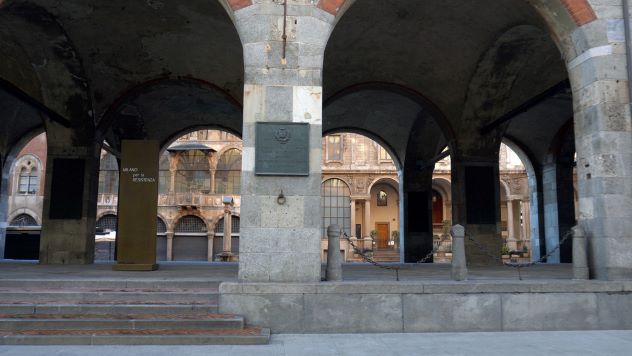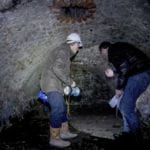 Our World
Our World  Our World
Our World  Weird Stuff
Weird Stuff 10 Fascinating Facts You Might Not Know About Snow
 Miscellaneous
Miscellaneous Top 10 Things Crypto Was Supposed to Change & What Actually Did
 History
History 10 Huge Historical Events That Happened on Christmas Eve
 Music
Music 10 Surprising Origin Stories of Your Favorite Holiday Songs
 History
History 10 Less Than Jolly Events That Occurred on December 25
 Weird Stuff
Weird Stuff 10 Funny Ways That Researchers Overthink Christmas
 Politics
Politics 10 Political Scandals That Sent Crowds Into the Streets
 Weird Stuff
Weird Stuff Ten Bizarre Facts About The Doge Meme
 Our World
Our World 10 Ways Your Christmas Tree Is More Lit Than You Think
 Our World
Our World 10 Archaeological Discoveries of 2025 That Refined History
 Weird Stuff
Weird Stuff 10 Fascinating Facts You Might Not Know About Snow
 Miscellaneous
Miscellaneous Top 10 Things Crypto Was Supposed to Change & What Actually Did
Who's Behind Listverse?

Jamie Frater
Head Editor
Jamie founded Listverse due to an insatiable desire to share fascinating, obscure, and bizarre facts. He has been a guest speaker on numerous national radio and television stations and is a five time published author.
More About Us History
History 10 Huge Historical Events That Happened on Christmas Eve
 Music
Music 10 Surprising Origin Stories of Your Favorite Holiday Songs
 History
History 10 Less Than Jolly Events That Occurred on December 25
 Weird Stuff
Weird Stuff 10 Funny Ways That Researchers Overthink Christmas
 Politics
Politics 10 Political Scandals That Sent Crowds Into the Streets
 Weird Stuff
Weird Stuff Ten Bizarre Facts About The Doge Meme
 Our World
Our World 10 Ways Your Christmas Tree Is More Lit Than You Think
10 Secret Structures and Hidden Attractions Around the World
Do you ever find yourself traveling to your favorite countries only to end up seeing the same places again and again? Or maybe you’re looking for a new and exciting attraction to discover in your home country.
Some of the entries on this list have been kept secret for decades, whereas others date back hundreds of years and remain largely unknown. To spice up your next vacation, check out the following secret places and hidden gems!
Related: Top 10 Amazing Hidden Histories From The World’s Most Famous Places
10 The Aventine Keyhole—Rome, Italy
In the beautiful city of Rome, an unassuming green door sits at the end of a cul-de-sac, and you’d be forgiven for walking past it and not giving it a second glance. This is no ordinary door, though—its keyhole provides a perfect, albeit tiny, view of one country and two nation-states, with St. Peter’s basilica perfectly positioned in the center.
This door leads to none other than the Priory of the Knights of Malta, a legendary religious order. When you look through the keyhole, you’ll see Italy, Malta, and Vatican City in your view! The property belonged to the Knights Templar in the early 12th century before being passed to the Knights of Malta in the 15th century.
The beautiful building you’ll see today is a church called Santa Maria del Priorato—the work of famous engraver and architect Giovanni Battista Piranesi—built in the 18th century. The architectural design of the church is inspired by ships and the sea, based on the tradition of Aventine Hill being compared to a ship.
The keyhole vista is perfectly lined up with the gardens, with the Vatican visible in the distance. It’s not known whether this was an intricately planned vista or just a case of serendipity.[1]
9 Passetto del Biscione—Rome, Italy
Those exploring Campo de Fiori in Rome will most likely walk straight past a hidden passageway that connects the Piazza del Biscione with Via di Grotta Pinta. Passetto del Biscione is a small passageway with an astonishing history.
It’s believed it was named after the symbol of the Orsini family—an eel. The Orsini family built a palace over the ruins of Rome’s first theater, the Theater of Pompey. But in 1796, the passageway was allegedly the scene of a divine miracle.
Within the alley is an image of the Madonna, which reportedly moved its eyes in the late 18th century. Naturally, this miracle attracted devout Christians from around the city, but the alley’s hidden location made it challenging for many people to witness this miracle.
The passageway was abandoned for decades but was finally restored to its current beauty in 2016. To this day, the image of the Madonna still attracts attention from visitors.[2]
8 Hidden Staircase in Penshaw Monument—Houghton le Spring, England
Built in 1844, Penshaw Monument is a spectacular sight, sitting atop Penshaw Hill in Tyne and Wear, England. The monument is a Greek temple replica, measuring a staggering 70 feet (21.3 meters) tall, and was built to commemorate the 1st Earl of Durham, John George Lambton.
But this 200-year-old Greek-inspired temple also has a spectacular secret—there’s a hidden spiral staircase inside one of the pillars! But the staircase was the scene of a tragedy in the 1920s when a teenager fell to his death.
Afterward, the staircase was closed for safety reasons and remained shut off for 90 years, except briefly during the mid-1960s when vandals broke the lock. When the National Trust took over the monument’s maintenance, the staircase was reopened in 2011. However, it’s only open on certain days, and there’s a fee just to climb it![3]
7 Traboules Secret Passages—Lyon, France
In the town of Lyon, France, a series of secret passageways once provided a quick and safe way for silk workers to move their goods to and from the markets. The traboules are now partially open for public viewing, twisting and winding through different buildings. The word traboules comes from a corruption of “trans-ambulare,” a Latin phrase meaning “to pass through.”
The earliest passageways date back to the 4th century and were built to allow people direct access to the town’s fresh supply of water rather than using the streets. It’s thought there are around 400 traboules in the town, but only a select few are open to the public—these are marked with an identification seal. The private passageways are behind locked gates and doors.
During the 19th century, the silk trade in the Croix-Rousse region of Lyon was booming. The traboules and courtyards that passed through the area were popular meeting places for local silk weavers, known as “Canuts.” There were around 25,000 silk looms in Lyon during the 1830s, and as more silk shops were opened, merchants began ripping off the artisan weavers with low wages and poor benefits.
Because of the strong competition, avaricious merchants, and uncertain economy, the silk weavers rebelled. They closed their workshops and came together, marching through the town. They gathered weapons from the armory and attempted to hold the silk industry hostage until a proper wage was decided. But this revolt was put to a very bloody stop.
Although roughly 10,000 Canuts faced criminal deportation, their efforts inspired future uprisings from workers.[4]
6 Scotland’s Secret Bunker—Airdrie, Scotland
Walking past a quaint little cottage in Scotland, most people would have no idea that a tunnel leading to a huge secret bunker lies underneath. Boasting 24,000 square feet (2,230 square meters) of space, Scotland’s Secret Bunker remained a secret for more than 40 years. The bunker is located 100 feet (33.3 meters) underground and comprises two levels, each as big as a soccer pitch.
If a nuclear war had happened, the secret bunker is where authorities would have governed the country from. It’s also part of the ROTOR system—a huge project to update the UK’s radar cover after World War II. It was made up of various sites with enormous underground bunkers that could withstand bombing.
Now obsolete as a shelter for the government, the bunker is a museum full of cold war artifacts. However, most of the items are recreated and sometimes inaccurate. That said, the bunker is home to a fascinating display of military vehicles from various countries, as well as Britain’s only Russian anti-aircraft missile.[5]
5 Secret Art Deco Tunnel under New Yorker Hotel—Manhattan, New York
The red sign of the New Yorker Hotel is most definitely a focal point of West 34th Street in New York. Although the hotel is frequently photographed as a landmark of the city, much of the building’s history is unknown. The New Yorker Hotel is full of secrets, including the mesmerizing Art Deco tunnel beneath West 34th Street.
Behind a sealed door, the passageway is full of old hotel chairs, carpets, fittings, and Art Deco tiling. As you walk through the tunnel, you’ll be taken directly underneath West 34th Street in a zig-zag line. There’s a brass door at the far end that, today, leads onto the platform by the E line.
The hotel archives include a 1930s brochure that promotes the tunnel, saying it’s “so convenient!” It also notes that the tunnel is one of the hotel’s best amenities since it connects to Penn Station and even stretches as far as the Empire State Building. Although the tunnel isn’t open to the general public, you can visit it accompanied by a tour guide.[6]
4 Drakelow Tunnels—Cookley, England
Those strolling through Kingsford Country Park in North Kidderminster, England, will probably be unaware of the secret, or rather “top” secret, military complex located underground. Situated near Birmingham, the tunnels have a somewhat interesting history.
Dug in the early 1940s, the tunnels were used to create a “shadow factory” for the car manufacturer Rover. A shadow factory was a production method formed in 1930s Britain. It allowed both machinery and knowledge to be cross-pollinated between industries, where experts could “shadow” each other.
The tunnels measured 3.5 miles (5.6 kilometers) and were used throughout the Second World War into the 1950s. But, by 1961, the British Government had converted some of the tunnels into secret “shadow government” headquarters. This was during the Cold War era, and the tunnels were to be used to run the country if things got nasty up top.
The Drakelow tunnels remained a secret until their decommissioning in 1993. The tunnels and equipment were sold to a private buyer. Since then, the Drakelow Tunnels Preservation Trust has worked hard to restore the underground complex, aiming to open a Cold War museum.
Although it’s a huge project, some of the tunnels are open to the public—there’s much to learn and lots of secrets to uncover down there![7]
3 The Whispering Gallery of Loggia dei Mercanti—Milan, Italy

Underneath the Palazzo della Ragione sits an open-air space known as the Loggia dei Mercanti. This is no ordinary space, though—it’s a hidden communication system. If you whisper to the columns, the archway will carry your voice to a strategically positioned person on the other side.
Part of the medieval-era square, the Loggia is also a whispering gallery. A remarkable acoustic anomaly that happens underneath archways and domed buildings, whispering galleries allow the quietest of noises to travel.
Many legends about the whispering gallery have been passed down, including how Renaissance and medieval merchants would use the unknown communication system to reveal secrets. Other legends describe how those in forbidden relationships would use the Loggia to whisper romantic words to each other.[8]
2 Hidden Newgate Prison Cells—London, England
London’s Newgate Prison was so terrifying, it’s enough to make anyone grateful to live in the present day! Situated near St. Paul’s Cathedral, the city’s worst criminals were incarcerated at Newgate for over 700 years until it was closed and demolished in 1904.
Newgate Prison was constructed in the late 12th century at the order of King Henry II. Throughout its 700-year operation, it housed the worst criminals in London, including highwaymen, cutthroats, and murderers.
These days, the once fear-inducing prison is home to London’s main Central Criminal Court, commonly known as the Old Bailey. There’s no sign of the infamous prison apart from a small plaque on the Court’s wall, but the remains of the Eastern Wall can be found on a residential street, Amen Court.
Across from there, it’s said that the last remains of the old Newgate jail cells lie deep beneath a Victorian gin palace, the Viaduct Tavern. Dark and eerie, the tiny cells give you an idea of what life was like in London’s most feared prison centuries ago. It’s rumored that these tunnels were connected to the main prison by a tunnel, but it’s not known if this is true or simply a local legend.
Although the Viaduct Tavern has been the subject of other rumors, including a brothel and an opium den being opened above the pub, it’s likely the mystery of the eerie cells below will never be solved. If you’d like to visit these hidden cells, have a friendly chat with one of the bartenders![9]
1 The Hidden Beach—Islas Marietas, Mexico
Hidden inside a beautifully lush island is Playa del Amor, a secret beach boasting lots of sun exposure and sparkling blue waters. Known as the Hidden Beach, Playa del Amor is part of the Marietas Islands—an uninhabited group of islands created by underwater volcanic eruptions.
Found approximately 22 miles (35.4 kilometers) west of the Mexican city of Puerto Vallarta, the Hidden Beach will make you feel like you’ve stumbled onto the set of a fantasy movie. With its white sand cavern and turquoise waters rushing in, this hidden gem is perfect for a romantic couple’s getaway.
Completely hidden from the outside, the aptly named Hidden Beach can only be reached via a water tunnel that links it to the Pacific Ocean. With around six feet (1.8 meters) of space above the water, you can either swim or kayak to this secret beach.[10]








